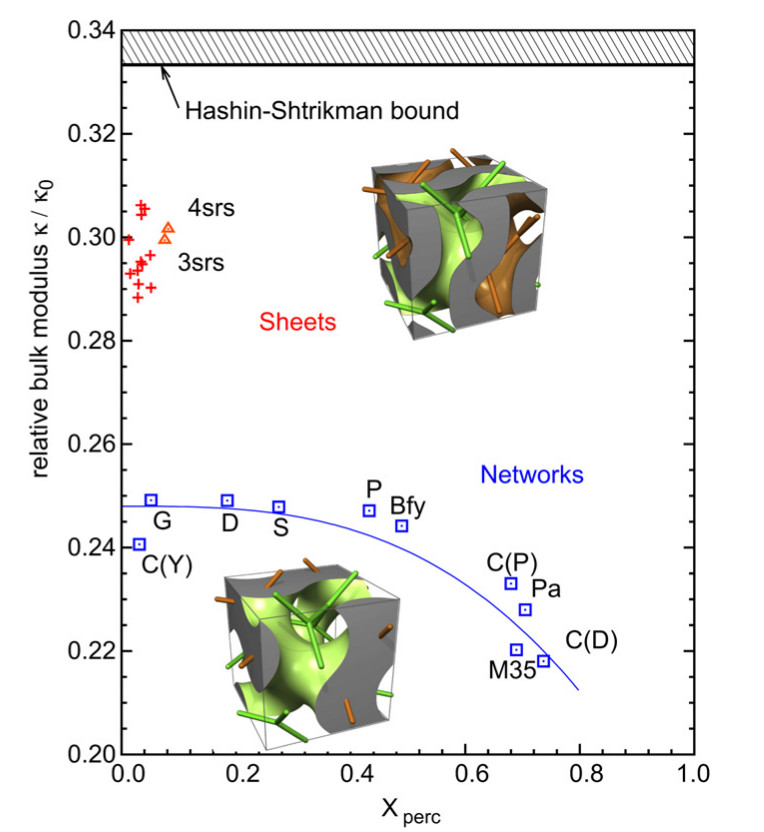These are the voxelised datasets that were used for FEM calculations of effective elastic properties and for Lattice Boltzmann calculations of permeabilities in our article
- S.C. Kapfer, S.T. Hyde, K. Mecke, C.H. Arns, and G.E. Schröder-Turk, “Minimal surface scaffold designs for tissue engineering”, Biomaterials 32(29), 6875-6882 (2011)
(Click here for Sebastian Kapfer’s page for voxelised data sets)
These data sets were used to obtain the following result which even now (in 2019) I consider quite amazing: “As the key result of this article, we have shown that, at the same solid volume fraction, sheet solids have a subs tantially higher effective bulk modulus k and direction-averaged Young’s modulus E than network solids, for a wide range of volume fractions and material parameters. While a comprehensive explanation of this behavior is elusive, it can be compared to the differences between hollow steel pipes and solid steel struts with respect to bending rigidity. In civil engineering, it is a well-known fact that at equal material usage, a hollow cylinder is preferrable to a solid cylindrical strut; the moment of inertia of the beam cross-section enters the bending rigidity. Minimal surface sheets act as the triply-periodic analogon of the hollow pipe, whereas network solids are representing networks of solid cylindrical struts.”
tantially higher effective bulk modulus k and direction-averaged Young’s modulus E than network solids, for a wide range of volume fractions and material parameters. While a comprehensive explanation of this behavior is elusive, it can be compared to the differences between hollow steel pipes and solid steel struts with respect to bending rigidity. In civil engineering, it is a well-known fact that at equal material usage, a hollow cylinder is preferrable to a solid cylindrical strut; the moment of inertia of the beam cross-section enters the bending rigidity. Minimal surface sheets act as the triply-periodic analogon of the hollow pipe, whereas network solids are representing networks of solid cylindrical struts.”



 tantially higher effective bulk modulus k and direction-averaged Young’s modulus E than network solids, for a wide range of volume fractions and material parameters. While a comprehensive explanation of this behavior is elusive, it can be compared to the differences between hollow steel pipes and solid steel struts with respect to bending rigidity. In civil engineering, it is a well-known fact that at equal material usage, a hollow cylinder is preferrable to a solid cylindrical strut; the moment of inertia of the beam cross-section enters the bending rigidity. Minimal surface sheets act as the triply-periodic analogon of the hollow pipe, whereas network solids are representing networks of solid cylindrical struts.”
tantially higher effective bulk modulus k and direction-averaged Young’s modulus E than network solids, for a wide range of volume fractions and material parameters. While a comprehensive explanation of this behavior is elusive, it can be compared to the differences between hollow steel pipes and solid steel struts with respect to bending rigidity. In civil engineering, it is a well-known fact that at equal material usage, a hollow cylinder is preferrable to a solid cylindrical strut; the moment of inertia of the beam cross-section enters the bending rigidity. Minimal surface sheets act as the triply-periodic analogon of the hollow pipe, whereas network solids are representing networks of solid cylindrical struts.”